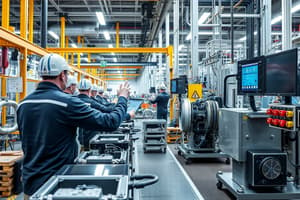Podcast
Questions and Answers
What is one of the characteristics of Industry 4.0 mentioned in the text?
What is one of the characteristics of Industry 4.0 mentioned in the text?
- Mass distribution of unmanned vehicles for personal use
- Limited usage of IoT in inter-machine communications
- Decrease in complexity and precision of manufactured technical products
- Transition from manual labour to robotics (correct)
Which component enables self-management of physical systems in Industry 4.0?
Which component enables self-management of physical systems in Industry 4.0?
- Advanced Robotics
- IoT (correct)
- Big Data/Advanced Analytics
- Wearables
What technology is used for constantly developing production systems in Industry 4.0?
What technology is used for constantly developing production systems in Industry 4.0?
- Advanced Robotics
- Big Data/Advanced Analytics
- Self-teaching programs (correct)
- Wearables
Which pillar of Industry 4.0 involves analyzing data and turning it into actionable information?
Which pillar of Industry 4.0 involves analyzing data and turning it into actionable information?
What part of Industry 4.0 framework involves 3D simulation of product development processes?
What part of Industry 4.0 framework involves 3D simulation of product development processes?
Which component of Industry 4.0 involves the interaction of robots with each other and learning from humans?
Which component of Industry 4.0 involves the interaction of robots with each other and learning from humans?
What technology is described as overlaying real-world views of production with virtual information?
What technology is described as overlaying real-world views of production with virtual information?
Which system refers to physical and engineering systems that can be tracked, coordinated, controlled, and integrated by computers and communication systems?
Which system refers to physical and engineering systems that can be tracked, coordinated, controlled, and integrated by computers and communication systems?
Which technology is best suited for producing small batch, customized, and high-performance products?
Which technology is best suited for producing small batch, customized, and high-performance products?
What system operates behind the scenes and deals with both the physical world and the virtual world?
What system operates behind the scenes and deals with both the physical world and the virtual world?
What does Horizontal Integration in Industry 4.0 refer to?
What does Horizontal Integration in Industry 4.0 refer to?
How does Industry 4.0 impact companies in terms of flexibility and speed?
How does Industry 4.0 impact companies in terms of flexibility and speed?
Flashcards are hidden until you start studying
Study Notes
Industry 4.0 Transition
- Shift from manual labor to robotics and autonomous systems
- Modernization of transport and logistical systems with unmanned vehicles
- Increase in complexity and precision of manufactured technical products due to improved production technologies
- Development of inter-machine communications and self-management of physical systems using IoT
Key Components of Industry 4.0
Physical to Digital
- Sensors and controls
- Wearables
- Augmented Reality
- Digital Signal aggregation, Optimization, and prediction
- Visualization and POU delivery
- Cognitive and high-performance computing
Digital to Physical
- Additive Manufacturing
- Advanced Materials
- Autonomous robotics
- Digital Design and simulation
Pillars of Industry 4.0 Framework
Big Data/Advanced Analytics
- Analyzing data to turn it into actionable information
Advanced Robotics
- Robots becoming more flexible, cooperative, and autonomous
- Interacting with humans and learning from them
Advanced Simulations
- 3D simulation of product development, material development, and production processes
- Enabling operators to test and optimize processes for products before production starts
AI/Cognitive Computing
- Using IoT, advanced data analytics, and cognitive technologies like AI and machine learning
Industrial Internet of Things (IIoT)
- Incorporating internet-connected devices that communicate with each other using standard protocols
Cybersecurity
- Providing secure, reliable communications and data flow throughout Industry 4.0 systems
Additive Manufacturing
- Best choice for producing small batch, customized, and high-performance products
Cloud-based Service Enabling Technologies
- Shifting data storage and management to the cloud for manufacturing execution systems
Augmented Reality
- Overlaying real-world views of production with virtual information
Integration
Horizontal Integration
- Data flow through IT systems across all manufacturing-related production and business planning processes
Vertical Integration
- IT systems connected to machines and devices at different levels of production hierarchy
Connectivity
- Interoperability through shared protocols in manufacturing process design
Cyber-Physical Systems
- Combining physical and engineering systems with computers and communication systems
Smart Factories
- Integrating physical and virtual worlds, operating behind the scenes
Opportunities and Benefits
- Increasing market variability, shorter product life, and higher product complexity drive companies to be more flexible
- Industry 4.0 accelerates innovations and puts consumers at the center
- Flexibility and reduced energy consumption
Studying That Suits You
Use AI to generate personalized quizzes and flashcards to suit your learning preferences.




